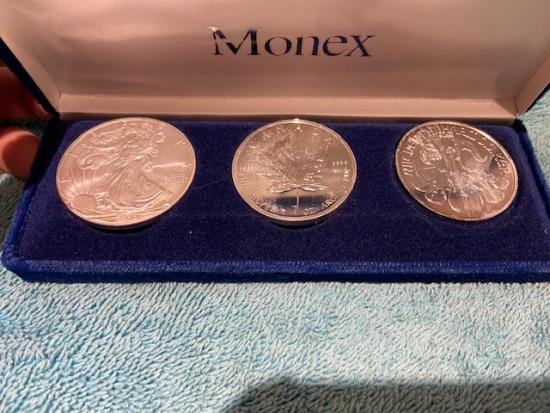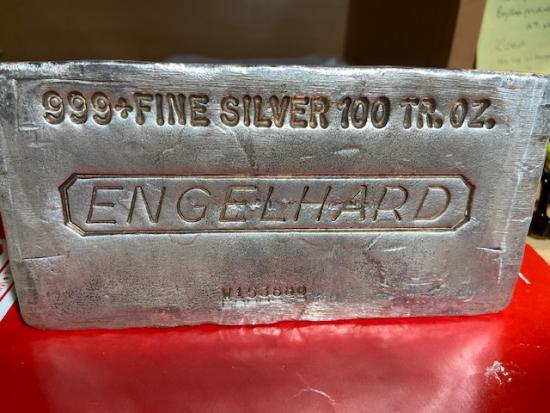
Silver set
One each of a Philharmonic, a Canadian Maple and Liberty
All great shape and in a collectors set
Selling close to spot and the middle coin is higher value in resale
Sold as a set
All one ounce 99.99% pure fine silver!
$140.00

100 ounce silver bar
Engelhard numbered serial number
On the web selling for $3,024.00
Estate sale at $1,890.00
Two already gone
Have a Johnson Matheny bar as well
Stamped and certified
999.% pure silver
In storage for decades
Either bar great store of value and away from prying eyes and government paper money schemes
Text me either set (530)559-1214
-------------------------------------------------------------------------
Gold is often called the metal of kings and the description also includes silver, sometimes called its younger brother.
Gold has been used as a form of money for centuries and its only in recent times its use as money has diminished.
That’s not to say it has gone away as a monetary tool. It is still stockpiled at central banks around the world and stashed away by consumers and investors alike. As a currency, it has many of the required characteristics that any sound money must have.
It is durable and can be buried in the dirt or ocean for centuries without harm. It is hard to come by. All the gold ever dug up could fit in a tennis court sized cube. It is divisible. One small ounce can be stretched into a thread miles long.
It easy to recognize and impossible to counterfeit. It is a consistent store of value as one ounce in Roman times was said to buy a suit of armor and a meal. That same ounce today can easily still buy a nice suit and a good steak.
Up until several decades ago, many investors and central bankers alike have scorned gold in lieu of paper money. Things like stocks, bonds, currencies, cyber currency (like Bitcoin) notes and debt instruments have been thought to be as good as.
Whether that statement holds true is left to individual opinion but central banks do still stockpile it and in times of monetary upset, those tendencies seem to increase.
China is rumored to have tons of gold and is adding more. Many other central banks including ours also stores copious amounts of it. The exact amounts each central bank has is somewhat of a closely guarded secret.
Although gold ownership was outlawed here in the United States in 1933, Americans were once again allowed to own it in 1974.
There are many ways to own gold and although currently running about $2,000 an ounce, it’s cheaper cousin silver also possesses similar physical qualities and investor perceptions as to its usefulness and is currently under $30 an ounce. That perception being gold and silver cannot be printed by central bankers, is a hard asset recognized worldwide, cannot be traced, is easily transported and basically autonomous in its possession.
Although gold and silver prices can languish for years, when their prices do move, the moves can be fast and furious.
It is thought investors flee to gold to protect against inflation and maintain financial privacy. It can be said when currencies go bad, buy gold and silver.
How exactly does a currency “go bad”?
Think Mexican Peso. That’s pretty much all you need to know.
Right now gold and silver prices are on the move again, gaining upwards of 50% to 90% in a few short months. Many analysts think this is only the beginning.
Why are prices rising?
The reasons could be many but likely include increased political and social tensions, the massive rescue programs from central banks everywhere which encompasses trillions of dollars in stimulus and rescue packages, and a virulent virus causing massive global shutdowns are but a few likely causes.
Gold and silver can be found in many forms. Old coins, current coin issues, small or large bars or generic rounds or even gold or silver jewelry is common. The most popular investor holding is one ounce coins or generic bars of different weights.
Right now the physical demand for coins is high and supplies are tight but you can find supplies if you are persistent. Small one or ten ounce bars are also a convenient way to hold these metals. Investors can also consider gold company stocks and funds but in my opinion the reason for going this route is slightly different and investors should know the reasons for owning one or the other.
This article is not meant as investment advice and is not a solicitation or recommendation to buy or sell any securities. Past performance is not guarantee of future results. Marc Cuniberti is an Investment Advisor Representative of Vantage Financial Group. A registered Investment advisor in California at 164 Maple St. # 1 Auburn, Ca 95603. The views expressed are opinion only and do not necessarily reflect the opinions of Vantage, any news media company, their staff, management or underwriters. Mr. Cuniberti website is moneymanagementradio.com. California Insurance License # 0L34249. Insurances services offered is from Mr. Cuniberti and not affiliated with Vantage Financial. (530) 559-1214


